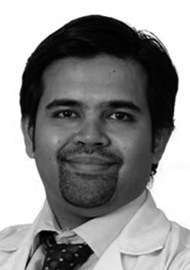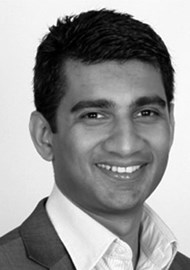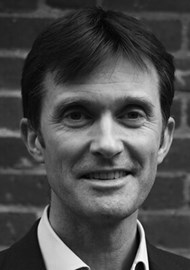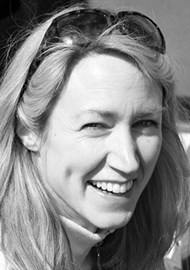Ever had a great idea for an innovation that would significantly improve your practice, but wondered how to go about developing it? Lucy Dalton interviewed three consultant ENT surgeons-come-successful innovators (one international, one novice and one experienced) who explain what it takes to turn ideas into real products: Jagdish Chaturvedi (Bengaluru, India), CEO of HiiiH Innovations Pvt Ltd; Declan Costello (Slough), co-founder of Airway Screen Ltd; and Ajith George (Stoke on Trent), Medical Director of endoscope-i.
Jagdish Chaturvedi
Please describe your current role and place of work
I am an ENT Surgeon specialising in minimally invasive nose and sinus surgery at Fortis Hospital in Bengaluru, India. I specialise in procedures that involve balloon dilation of the paranasal sinuses and Eustachian tubes. I am also the Founder and CEO of HiiiH Innovations Pvt Ltd (HiiiH is pronounced as Hi).
When did you first have an idea for a medical device that you took from the point of conception to the point of sale – what was the idea, and did the final product resemble what you had originally conceived?
In 2010 I had the idea for a portable, robust, low-cost, low-maintenance ENT video endoscopy system for diagnosis and endoscopic procedures in rural India. As the product developed, it was licensed out to Medtronic. They were looking for a portable, low-cost ENT endoscopy solution for community health workers to perform remote screening for ear diseases. In order to successfully license out the technology to them, we modified our original design of the device to suit the community health worker’s skill, and its usability for the screening of ear diseases. So, ultimately, our final product was only able to perform this function.
What innovations have you successfully seen through to production and point of distribution or sale?
I have been involved in the development of 18 medical devices, and have seen eight medical devices through to production and point of distribution or sale. These devices are:
- Entraview – a portable video endoscopy tool for remote healthcare workers;
- Sinucare – a low-cost balloon sinuplasty device;
- Eustacare – a low-cost eustachian tube balloon dilation system;
- Noxeno – a nasal foreign body extractor for community physicians;
- Vap care – a secretion management system for those who have prolonged intubation in order to prevent ventilator-associated pneumonia;
- Saans – a paediatric, mechanical CPAP device for use during transportation of children with respiratory distress;
- Parasafe – for safer abdominal paracentesis;
- Thorashield – for safer pleural tapping.
In your experience, what are the stages involved in developing an initial idea into a medical product that can be marketed?
I have found the stages involve:
- Team creation;
- Detailed clinical immersion activity;
- Assessment of unmet needs with identification of a compelling unmet need;
- Brainstorming and concept generation;
- Development of a proof of concept and then a prototype, followed by benchtop testing of the prototype until it is refined and ready for clinical testing;
- Clinical studies;
- Patent filing;
- Human factor analysis;
- Regulatory compliances and certifications;
- Stakeholder analysis, business model selection and ‘go to market’ strategy are required before the launch of the product;
- Manufacturing, packaging, labelling, and development of training protocols are essential before early adopter usage.
Have you learnt any key lessons in developing a novel medical product?
I have learnt two key lessons: first you need to create a team before developing solutions for your novel idea. This is critical for ensuring strong leadership to take an idea all the way to commercialisation and scale. Secondly, make provision for an adequate marketing budget, even if your new device aims to solve a large clinical need. Innovators often assume that accompanying technology will reduce the marketing effort required. However, most of the time this is not true, as new technologies require behavioural changes and these changes need several rounds of marketing.
Would you do anything differently next time?
The one thing that I have learnt the hard way is that the business model and marketing strategies of a potential technology should be considered at the time of idea development. This can save a huge amount of time and money, and prevent devices having to be significantly modified at a later stage to suit pricing, marketing and commercialisation.
What would be your top tip for anyone with exciting ideas for novel medical devices?
My top tip would be to create a cross-disciplinary team, including a physician, an engineer or designer, and a business graduate. This composition takes into account the key skills required to take a product from an idea to commercialisation. My next tip would be spend at least two months in a clinical setting, carrying out clinical observations to identify the most compelling unmet clinical need. Often, the combination of clinical need for, and poor market impact of a new product leads to the longest journey to commercialisation and scale.
How would you counsel a younger you regarding turning your ideas for a new medical device into reality?
I would say spend more time validating and understanding the problem your innovation is trying to address, rather than jumping to an exciting solution that may not be the best way to solve the problem.
Can you make money from developing novel medical devices?
Yes, absolutely. However, it can take as long as three years from the ideas stage to generate revenue, and five to seven years to break even and generate profits. Once the device has completed necessary clinical trials, there is also a good chance of licensing it out to a third party.
How much starting capital is required to develop an idea for a new product into the real thing?
In the context of India, we require £50,000 to £100,000 of seed capital and a total of up to £250,000 to develop a moderately complex medical device for sale in a span of 24-30 months. I have raised capital from private and government grants, as well as angel investors.
Are there any common pitfalls you would now know how to avoid from your experience?
There are many pitfalls, however the most important one is to have an adequate budget and to plan for packaging, labelling, training activities and marketing. Most innovators spend a lot of time and money developing and testing their technologies, and underestimate the effort and funding required for branding, marketing and commercialisation activities.
Is there any particular infrastructure that you recommend new innovators should pay attention to from the start?
I would recommend aspiring innovators have at least five years of professional working experience before venturing into entrepreneurship. Further, I suggest investing one’s own money at the time of idea generation, so that the proof of concept and patent filing can be completed before external fundraising takes place. This increases the chance of grant funding and angel investment.
How did your fellowship at Stanford help you with subsequent innovations you have developed? Can you recommend any other fellowships, courses or opportunities that might catalyse other young medical innovators’ journeys into innovation?
The Stanford India Biodesign Fellowship programme (in 2012) helped me understand the importance of spending more time and research on the problem versus the solution. Understanding the problem in great detail can help identify the most appropriate solution, which can be time and cost effective. The importance of creating a team before generating ideas was also a key learning point of the programme - at the end of the day, you need a good team that can take any idea to fruition successfully.
Stanford University has a global biodesign programme, and similar biodesign programmes are run by the Universities of Missouri and Minnesota. Other courses that have similar philosophies are run by John Hopkins University and Massachusetts General Hospital, and Harvard University, Cambridge University, and Oxford University also run innovation programmes. In India, the School of International Biodesign and programmes run by the Indian Institute of Technologies teach a structured process of innovation.
Through my new startup company, HiiiH Innovations Private Limited, we run an online certificate course on healthcare innovations to help entrepreneurs learn the process of biodesign from the comfort of their homes through a mutually convenient schedule. I have also authored a book called Inventing Medical Devices: A perspective from India that describes the key learning points from my experiences in biodesign.
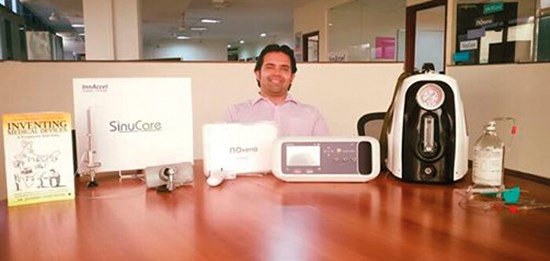
Jagdish Chaturvedi with seven years’ worth of his innovations.
Have there been any comedy moments along the path of innovations for you?
Yes, there have. We were developing a low-cost, easy-to-use nasal foreign body removal device. After carrying out field testing with community-level physicians, we received clear feedback that the device was too simple to use. We were surprised, but soon discovered that if the procedure appears too simple, it will be hard to charge a gold fee for it. We were then asked to make the device appear more complex! This was an insight we never anticipated, but we then realised the importance of revenue generation among community level physicians, who largely depend on out of pocket payments.
In your opinion, are there any particular character traits that make for a good innovator?
A good innovator should be willing to take appropriate financial risks before seeking external funding. In addition, a good innovator should be a good team player and trust in the domain expertise of other team members.
If there is any spare time in your busy life, how would you choose to spend it? What are your hobbies?
Well, I am known for my multitasking abilities. In addition to being a practising ENT surgeon and a serial innovator, I am also a professional stand-up comedian. I typically perform eight to 10 stand-up comedy shows every month, whenever I have some free time. I have also showcased my innovation journey from being a doctor to becoming an innovator through a humorous webseries called Starting Troubles which is streaming on www.hiiih.in and on the app HiiiH (available on iOS and Android).
What is your next new idea?
My next idea is a part of my new startup company called HiiiH (www.hiiih.in). For the first time, I have ventured into providing expert services to doctors and healthcare startup companies across the world, to provide support in all the steps of innovation, from ideation, product development, to marketing and commercialisation. Given the COVID-19 pandemic, we are developing new products and services to enable tele-examination and remote procedures in the field of ENT. We are also running online courses on innovations and entrepreneurship in healthcare.
A comedy webseries based on Jagdish Chaturvedi’s innovation journey, called Starting Troubles, is now streaming on Amazon Prime Video UK and on www.hiiih.in
Documentary by Channel News Asia: www.mewatch.sg/en/series/field-guide-to-innovation/ep2/470317
Jagdish Chaturvedi
Consultant Nose and Sinus Surgeon, Fortis Hospital Bannerghetta Road Bengaluru; Founder and CEO, HiiiH Innovations Pvt Ltd.
Declan Costello
Please describe your current role and place of work.
Consultant ENT Surgeon specialising in voice disorders at Wexham Park Hospital, Slough.
When did you first have an idea for a medical device that you took from conception to the point of sale? Did the final product resemble your original idea?
The idea for the COVID Airway Screen actually came from a doctor in Taiwan – he wanted to protect healthcare workers during airway procedures such as intubations (or mouth/tube care on ITU). He simply created a Perspex box that rested over the head of the patient. The anaesthetist would reach into the box to intubate the patient, minimising exposure to droplets. My wife (a scientist in a law firm) was contacted by one of her lawyer colleagues to ask whether it could be useful in the UK, particularly early on in the pandemic when we thought we were going to run out of PPE. We ran an amazingly successful Crowdfunder campaign which raised about £25k in just a few weeks. Our device is here: www.airwayscreen.com
In your experience, what are the stages involved in developing an initial idea into a medical product that can be marketed?
In my experience, the steps are:
- ‘Lightbulb’ moment;
- Development – need to speak to stakeholders:
– Is this needed?
– Is it marketable?
– Is it scalable? - Prototype production and testing – usually multiple iterations – to finalise and refine design;
- Patent application if required;
- Regulatory approval (can be very complicated and lengthy, involving – in UK – MHRA);
- Consider legal aspects – contracts, potential litigation, risk assessment, insurance;
- Website, social media and other promotion;
- Creation of a limited company;
- Production at scale;
- Sales and distribution network;
- Post-production surveillance.
Have you learnt any key lessons in developing a novel medical product?
Don’t underestimate how much time it will take! In the COVID pandemic, people have been incredibly keen to help, but in ‘normal’ times, I can imagine it would take a lot of persuasion to get people on board.
Would you do anything differently next time?
Not really… it’s been fun!
What would be your top tips for anyone with exciting ideas for novel medical devices?
Consider the legal and regulatory aspects early on – these can be quite significant.
How would you counsel a younger you regarding turning your ideas for a new medical device into reality?
Be enthusiastic and a passionate advocate for your idea. If you think it’s a good idea, the chances are there are lots of other people who also think so. You will always encounter naysayers who will try to put you down or pick holes in your project. It’s much easier to be negative than to be positive, so don’t be put off.
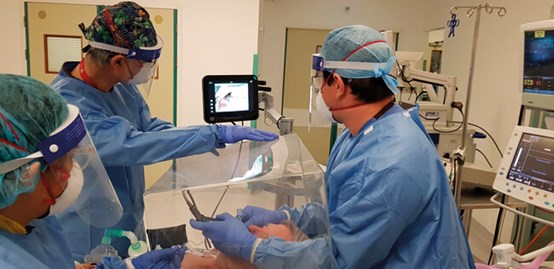
The Airway Screen in action, during the intubation of a patient.
Is there any particular infrastructure that you recommend new innovators should pay attention to from the start?
Find a friendly lawyer who is prepared to help with setting up a limited company. Personally, I had no idea how this worked, so it was good to have some guidance. Also, it’s helpful to have a mentor who has done this before to provide guidance.
Can you make money from developing novel medical devices?
We weren’t trying to make money… it was all developed using the Crowdfunder monies.
How much starting capital is required to develop an idea for a new product into the real thing?
We were able to get started with just a few hundred pounds for the raw materials, but everyone else (factories, distributors, lawyers, etc.) were working for free, so we were incredibly lucky.
Are there any common pitfalls you would now know how to avoid from your experience?
Don’t be too polite! If you want some help, ask for it. And be prepared to use all of your personal contacts.
Have there been any comedy moments along the path of innovations for you?
We started by making cardboard cutouts of our design, and tested it on our sons by lying them on the kitchen table to simulate intubation. Not something they had in mind for the lockdown!
Declan Costello
Consultant Ear, Nose and Throat Surgeon, Wexham Park Hospital, Slough, Berkshire, UK
Ajith Paulose George
Please describe your current role and place of work.
I am the Medical Director of a Birmingham based SME (endoscope-i) specialising in medical innovations, I also lecture on anatomy at Keele University, I lead on cadaveric surgical simulation for Health Education England School of Surgery West Midlands and I am also a head and neck surgeon in Stoke on Trent.
When did you first have an idea for a medical device that you took from conception to the point of sale? Did the final product resemble your original idea?
Back in March 2012 when the capability of the iPhone camera was being recognised, I conceived the idea of ‘endoscopic mobile imaging’. Essentially using the iPhone camera to capture images of the larynx, ear and nasal cavity. I promptly realised to make this happen I needed to surround myself with very clever people. That’s when I joined forces with Chris (peer ENT Consultant), Mark (our lead Engineer from Aston University) and Simon (our Technical Director and guru of all things software). In doing so, the product went on sale a year later and has been selling ever since. The final product was in fact hundreds of iterations away from the very first prototype. We never realised how important the subsequent app was to make this work alongside the initial endoscope phone clip.
In your experience, what are the stages involved in developing an initial idea into a medical product that can be marketed?
I suggest the following:
- Find clever people you can trust. You need a team;
- If it’s really a good idea, consider an early patent application;
- Constantly think about how your product can be improved within your team and relate this to real life;
- Ask people you respect, who are not part of the team, for their opinions - the more the better;
- Be prepared for a lot of criticism and negative responses about why your idea won’t work;
- Have answers for all the above criticisms;
- Think about money and funding;
- Ask the experts in the industry;
- Build a business model (no matter how rough this may be);
- Build the prototype;
- Give it a good name and use this as much as possible so people hear about it;
- Test it in as safe a way as possible; Learn about CE marking (ideally have someone in your team who can do this!);
- By this stage, if you get this far, it’s a pretty good idea and people will start to take notice;
- Keep testing, keep thinking, keep improving;
- If the device is good, this is the stage at which someone will offer to distribute it, collaborate to develop it further or acquire the product;
- Answer all customer questions promptly. You should have all the answers from the development process;
- Support your early adopters - they are brilliant;
- Have fun;
- Sell your product and go on and do something else even better!
Have you learnt any key lessons in developing a novel medical product?
Yes! We (endoscope-i) have a lot of ‘great ideas’, hundreds of them in fact. Truly great ideas spend very little time as an idea and quickly become a product. Bad ideas remain ideas.
Would you do anything differently next time?
No. Every part of this has been a load of fun with friends. We accept failure is part of our learning experience – it just makes us want to do things better.
What would be your top tip for anyone with exciting ideas for novel medical devices?
Surround yourself with people cleverer than yourself.
How would you counsel a younger you regarding turning your ideas for a new medical device into reality?
For medical innovation, be patient. The real medical world is way behind the ‘innovative’ world we hear so much about. It has taken us eight years to get to where we are today.
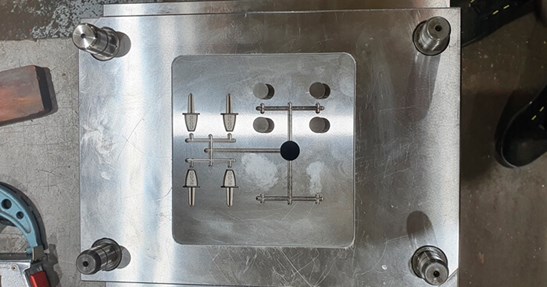
Injection moulding of the SNAP device by Form, UK.
Can you make money from developing novel medical devices?
If your ambition is to make money, then I cannot see how medical devices are the way. If you like to do something awesome to try and make things better for patients and your colleagues, then medical device innovation is for you!
How much starting capital is required to develop an idea for a new product into the real thing?
My mum loaned me £1000 to build the first 3D-printed prototype and CAD. I have not yet paid her back – sorry mum! Seriously though, the cost is expertise. If your company base has the inward expertise, you will find you can do a lot of things yourself and do them better: design, prototyping, CE marking, risk assessments, clinical testing, marketing, website design, graphics and so forth. Without that, you will be throwing money at people to do these tasks who are not really invested in your idea.
Are there any common pitfalls you would now know how to avoid from your experience?
We have seen a few companies come and go who really jump in big with early angel investments and start-up funding. Just be prepared that this will all have to be paid back, and the enjoyment will soon seep away when paying back debts is the focus of your attention. Endoscope-i started off being self-funded. It’s amazing how careful you are with your own money – decisions are made with much more care and consideration. So be careful with money, whether that’s yours or someone else’s.
Have there been any comedy moments along the path of innovations for you?
A French television channel released a TV exposé after they identified us as the company that created a ‘technical fraud detection’ app for the governing body of cycling the UCI. This multi-billion-pound sport had been effectively rescued by ‘Four Cool Tech Kids’ (their quote, not ours) form Birmingham, sitting round a table, eating pizza and drinking beer. The French were far from pleased. We did look rather cool
on TV!
Ajith Paulose George
FRCS (ORL-HNS), Medical Director, endoscope-i

